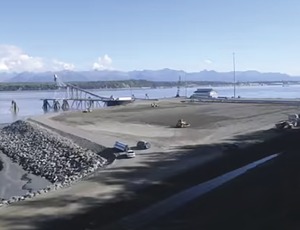
With continuing oil-price impacts on Alaska jobs and a looming state budget impasse that could send thousands of public employees to the unemployment line, Gov. Bill Walker (I) on June 10 reinstated a 90% local-hire rule for state-funded construction projects. The rule, which would affect both blue- and white-collar jobs, is drawing a mixed reaction from local contractors.
According to Walker, a governor is allowed to restore the rule if Alaska joblessness remains significantly above the national average. State unemployment reached 6.8% in May, compared to a national average of 5.5%, says the U.S. Labor Dept. Suspended in 2013, the rule takes effect on July 1. "Relatively low oil prices mean depressed capital budgets, and depressed oil company investments may remain with us for some time," said Walker in a statement. "In these economic circumstances, Alaska hire is more important than ever." He said the rule "is good for workers, but it's also the right decision from the perspective of quality projects. Alaskans will do the job right because we're the ones who will drive on those roads and use that infrastructure."
But John MacKinnon, president of the state chapter of the Associated General Contractors, told ENR there was no forewarning provided to the construction industry or consultation before the announcement. He says that while the rule is meant to protect and support local engineers, architects and construction workers, it actually can add complexity to contract requirements, project specifications and profitability, MacKinnon says.
Further, AGC doubts that Walker's administration met the strict requirements for imposing the 90% rule: The rate of unemployment within the area must be at least 10% greater than the national average for the previous year, and at least 10% of the jobs in a particular craft or occupation on a publicly funded project could be filled by Alaska residents. "All they did was a simple calculation to see that Alaska was 10% over the U.S. [unemployment rate]."
A Walker spokeswoman does not anticipate major project impacts. The governor noted the rule would apply to future jobs, which include a $120-million rail extension at Port MacKenzie, near Anchorage, and expansion of the Seward Meridian Parkway, a $30-million project. "These requirements are not retroactive, so they do not apply to projects that were already bid on and might already be under construction," she says. The spokeswoman notes Alaska's "outstanding system of vocational training programs" and says contractors who can't find Alaskans trained to complete a job "can obtain a waiver to hire non-residents."
MacKinnon says there are a sufficient number of locals to fill the jobs but notes potential problems on rural projects, regarding some highly skilled crafts, and the state's short construction season. While the rule applies to architecture and engineering positions, MacKinnon says it doesn't apply to off-site processing work, He adds that, in the past, the rule "has never been enforced on A/E work."


Post a comment to this article
Report Abusive Comment